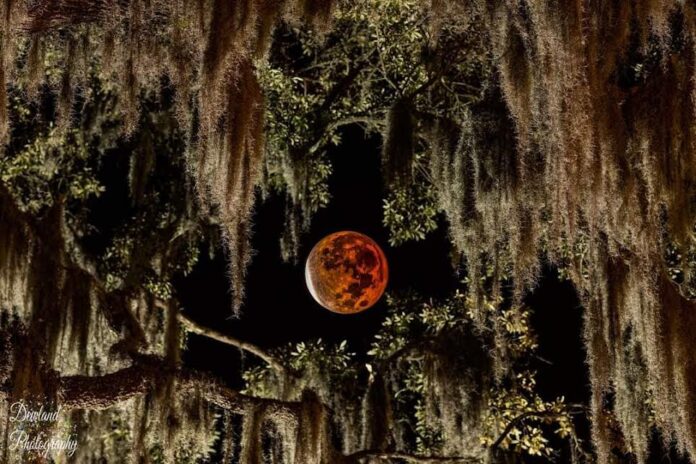Get ready for another celestial event in the sky over Beaufort SC. Our last total lunar eclipse in the Lowcountry until the year 2025 comes next week. The eclipse will take place in the morning hours of Tuesday, November 8th, with the moon turning red in the Earth’s shadow in the western sky.
When it comes to this eclipse, as long as we have clear conditions, the best viewing will be from 4-6 am. With the moon being low in the sky it is best if you can get away from any surrounding trees that could block the view. Along the Atlantic Seaboard, including Beaufort SC, the moon will set while it begins to emerge from total eclipse.
This will be the second lunar eclipse this year; the last one took place on May 16th. You may want to try and catch this one next week as there won’t be another total lunar eclipse until March 14, 2025.
In all, it’s estimated that some 2.7 billion people worldwide will have an opportunity – weather permitting – to enjoy the best part of this lunar show.
A total lunar eclipse has five stages, with different things to watch for at each, according to Space.com.
The first penumbral stage begins when the moon’s leading edge enters the pale outer fringe of the Earth’s shadow, called the penumbra. But the shading is so weak that most people won’t notice anything until about 70% of the lunar disk is immersed into the penumbra; or about 20 minutes before first contact with the much darker umbral shadow. Some folks with exceptionally acute vision can detect the penumbra when the moon has intruded about halfway across the penumbra or about 30 minutes before it first touches the umbra. Watch for a slight darkening to become apparent on the moon’s upper left side. The penumbral shading (or “smudge”) becomes stronger as the minutes tick off and the moon moves deeper in.
The second stage is partial eclipse. This begins much more dramatically when the moon’s leading (left) edge enters the umbra, Earth’s inner shadow, where no direct sunlight reaches. With a telescope, you can watch the edge of the umbra slowly engulfing craters, mountains and lunar maria (the darker plains on the moon’s surface), as your local night sky slowly and progressively gets darker. Take note of the Pleiades star cluster, which will be situated high above the moon, becoming more prominent as the eclipse progresses.
A little over an hour into partial eclipse, only a final bright sliver of moon remains outside of the umbra. And the rest of the moon is likely showing an eerie reddish/coppery glow. The contrast in both light and color have led some to refer to this as the “Japanese lantern effect.”
Next comes the third stage: the total eclipse, beginning when the last rim of the moon slips into the umbra. Although the sun here is completely hidden, the moon is likely to glow some shade of red or orange. These hues are caused by sunlight skimming and bending through Earth’s atmosphere: it’s the combined light of all the sunrises and sunsets that ring our world at any given moment. If an astronaut were standing on the moon, he or she would see the sun completely hidden and the dark disk of the Earth (appearing nearly four times larger than the moon does for us) surrounded by thin ring of red or orange light. And that light, in turn, falls across the surrounding lunar landscape.
As was the case last May, the duration of totality will run unusually long, lasting 85 minutes. And then, as the moon continues eastward along its orbit, events recur in reverse order. The moon’s leading edge re-emerges into sunlight, ending totality and beginning stage four: partial eclipse again.
When all of the moon escapes the penumbra, only the last penumbral shading is left for stage five. This final duskiness slowly fades away, leaving the brilliant mid-autumn full moon to resume its normal guise.










